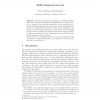Free Online Productivity Tools
i2Speak
i2Symbol
i2OCR
iTex2Img
iWeb2Print
iWeb2Shot
i2Type
iPdf2Split
iPdf2Merge
i2Bopomofo
i2Arabic
i2Style
i2Image
i2PDF
iLatex2Rtf
Sci2ools
95
Voted
SPW
2005
Springer
2005
Springer
Multi-channel Protocols
We examine several ad-hoc pairing protocols that strengthen their radio exchanges with additional transmissions over another channel, for example a screen showing graphically encoded information to a camera. Additional channels may have limited capacity and may still be subject to eavesdropping, but they may offer specific advantages over radio such as data origin authenticity. A single protocol may profitably use more than one channel, each with its own specific security properties, for different messages in its trace. Making this option explicit allows for further advances in protocol design. We also present an intriguing asymmetric protocol that achieves results comparable to mutual authentication even though the verification happens only in one direction.
Ad-hoc Pairing Protocols | Data Origin Authenticity | Intriguing Asymmetric Protocol | Security Privacy | SPW 2005 |
Related Content
| Added | 28 Jun 2010 |
| Updated | 28 Jun 2010 |
| Type | Conference |
| Year | 2005 |
| Where | SPW |
| Authors | Ford-Long Wong |
Comments (0)

